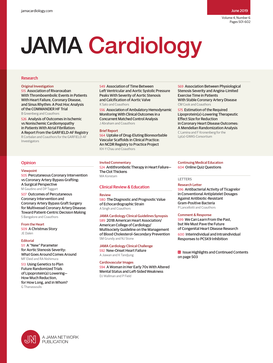Clonal Hematopoiesis and Cardiovascular Disease and Bleeding Risk and the Effectiveness of Aspirin.
IF 14.1
1区 医学
Q1 CARDIAC & CARDIOVASCULAR SYSTEMS
引用次数: 0
Abstract
Importance Clonal hematopoiesis of indeterminate potential (CHIP) has been associated with increased risk of cardiovascular disease (CVD) events and mortality. However, there are no approved therapies for preventing or treating CHIP. Objective To investigate whether low-dose aspirin might benefit older adults with CHIP for the primary prevention of CVD. Design, Setting, and Participants This was a prespecified substudy of the Aspirin in Reducing Events in the Elderly (ASPREE) double-blind, randomized clinical trial of daily low-dose aspirin vs placebo evaluating disability-free survival, which took place at primary and community care facilities in the US and Australia. Enrollment was from March 2010 to December 2014, and the randomized trial ended in June 2017. Community-dwelling Australian adults aged 70 years and older without a diagnosed cardiovascular event, atrial fibrillation, a serious intercurrent illness likely to cause death within the next 5 years, anemia, or a current or recurrent condition with a high risk of bleeding were included in the original study. Of 19 114 in the original trial, 11 402 were included in the substudy, and 9434 were included in the analysis. Follow-up for this substudy went through June 2022, with data analysis in February 2025. In-trial median (IQR) follow-up time was 4.6 (3.5-5.6) years, and posttrial observational follow-up was 8.7 (7.5-10.1) years from randomization. Interventions Participants were randomized to aspirin, 100 mg, daily or placebo. Main Outcomes and Measures CHIP was measured in blood specimens collected at trial entry. Major adverse cardiovascular events (MACEs), including fatal and nonfatal ischemic stroke, nonfatal myocardial infarction and coronary heart disease death, and clinically significant bleeding were adjudicated by independent expert committees blinded to trial-group assignments. Results A total of 9434 participants (median [IQR] age, 73.7 [71.6-77.1] years; 5067 [54%] female) provided a sample at baseline for analysis, 2124 of whom (23%) had CHIP at variant allele fraction (VAF) ≥2%, with 532 (5.6%) at ≥10% VAF. CHIP was not associated with increased risk of MACEs at 2% to 10% VAF (adjusted hazard ratio [aHR], 0.84, 95% CI, 0.68-1.03; P = .09) or ≥10% VAF (aHR, 0.80, 95% CI, 0.57-1.12; P = .19). However, CHIP was associated with increased risk of clinically significant bleeding (2%-10% VAF: aHR, 1.24; 95% CI 1.02-1.51; P = .03; ≥10% VAF: aHR, 1.21; 95% CI, 0.85-1.73; P = .28). There was no evidence of a differential effect of aspirin according to presence of CHIP on MACEs (without CHIP: HR, 0.91; 95% CI, 0.72-1.16; 2%-10% VAF: HR, 1.40; 95% CI, 0.77-2.53; ≥10% VAF: HR, 1.33; 95% CI, 0.52-3.37; heterogeneity P = .35) or clinically significant bleeding (without CHIP: HR, 1.64; 95% CI, 1.22-2.30; 2%-10% VAF: HR, 1.45; 95% CI, 0.82-2.57; ≥10% VAF: HR, 1.41; 95% CI, 0.49-4.07; heterogeneity P = .91). Conclusion and Relevance In this secondary analysis of a randomized clinical trial of daily low-dose aspirin in healthy adults 70 years and older, CHIP was not associated with higher CVD risk. However, participants with CHIP had a greater risk of clinically significant bleeding. There was no evidence that participants with CHIP were more likely than those without CHIP to benefit or experience more harm from aspirin when used for primary prevention of CVD events. Trial Registration ClinicalTrials.gov Identifier: NCT01038583.克隆造血与心血管疾病和出血风险及阿司匹林的有效性。
不确定潜力(CHIP)的克隆造血与心血管疾病(CVD)事件和死亡率增加相关。然而,目前还没有批准的预防或治疗CHIP的疗法。目的探讨低剂量阿司匹林是否有利于老年CHIP患者心血管疾病的一级预防。设计、环境和参与者:这是阿司匹林减少老年人事件(ASPREE)双盲随机临床试验的预先指定亚研究,每日低剂量阿司匹林与安慰剂评估无残疾生存,在美国和澳大利亚的初级和社区护理机构进行。入组时间为2010年3月至2014年12月,随机试验于2017年6月结束。最初的研究纳入了居住在澳大利亚社区的年龄在70岁及以上的成年人,他们没有被诊断出心血管事件、心房颤动、在未来5年内可能导致死亡的严重并发疾病、贫血或当前或复发的出血高风险疾病。在原始试验中的19例 114例中,11例 402例被纳入子研究,9434例被纳入分析。该子研究的随访持续到2022年6月,数据分析于2025年2月进行。试验中位(IQR)随访时间为4.6(3.5-5.6)年,试验后观察随访时间为8.7(7.5-10.1)年。干预:参与者被随机分为阿司匹林组、100毫克组、每日组和安慰剂组。主要结局和测量chip在试验开始时采集的血液标本中进行测量。主要不良心血管事件(mace),包括致死性和非致死性缺血性卒中、非致死性心肌梗死和冠心病死亡,以及临床显著出血,由独立专家委员会对试验组分配进行盲法裁决。结果9434名参与者(中位[IQR]年龄73.7[71.6-77.1]岁,女性5067名[54%])提供基线样本进行分析,其中2124名(23%)变异等位基因分数(VAF)≥2%,532名(5.6%)VAF≥10%。在VAF为2% ~ 10%时,CHIP与mace风险增加无关(校正风险比[aHR], 0.84, 95% CI, 0.68-1.03; P =。09年)或≥10% VAF (aHR, 0.80, 95% CI, 0.57 - -1.12; P = .19)。然而,CHIP与临床显著性出血风险增加相关(2%-10% VAF: aHR, 1.24; 95% CI 1.02-1.51; P = 0.03;≥10% VAF: aHR, 1.21; 95% CI, 0.85-1.73; P = 0.28)。没有证据表明阿司匹林根据CHIP的存在对mace有不同的影响(无CHIP: HR, 0.91; 95% CI, 0.72-1.16; 2%-10% VAF: HR, 1.40; 95% CI, 0.77-2.53;≥10% VAF: HR, 1.33; 95% CI, 0.52-3.37;异质性P =。35)或有临床意义的出血(无CHIP: HR, 1.64; 95% CI, 1.22-2.30; 2%-10% VAF: HR, 1.45; 95% CI, 0.82-2.57;≥10% VAF: HR, 1.41; 95% CI, 0.49-4.07;异质性P = 0.91)。结论和相关性在一项70岁及以上健康成人每日低剂量阿司匹林的随机临床试验的二级分析中,CHIP与更高的心血管疾病风险无关。然而,CHIP患者发生临床显著性出血的风险更大。没有证据表明CHIP患者在用于心血管疾病一级预防时比非CHIP患者更有可能受益或遭受更多伤害。临床试验注册号:NCT01038583。
本文章由计算机程序翻译,如有差异,请以英文原文为准。
求助全文
约1分钟内获得全文
求助全文
来源期刊

JAMA cardiology
Medicine-Cardiology and Cardiovascular Medicine
CiteScore
45.80
自引率
1.70%
发文量
264
期刊介绍:
JAMA Cardiology, an international peer-reviewed journal, serves as the premier publication for clinical investigators, clinicians, and trainees in cardiovascular medicine worldwide. As a member of the JAMA Network, it aligns with a consortium of peer-reviewed general medical and specialty publications.
Published online weekly, every Wednesday, and in 12 print/online issues annually, JAMA Cardiology attracts over 4.3 million annual article views and downloads. Research articles become freely accessible online 12 months post-publication without any author fees. Moreover, the online version is readily accessible to institutions in developing countries through the World Health Organization's HINARI program.
Positioned at the intersection of clinical investigation, actionable clinical science, and clinical practice, JAMA Cardiology prioritizes traditional and evolving cardiovascular medicine, alongside evidence-based health policy. It places particular emphasis on health equity, especially when grounded in original science, as a top editorial priority.
 求助内容:
求助内容: 应助结果提醒方式:
应助结果提醒方式:


